
llm-on-ray
Pretrain, finetune and serve LLMs on Intel platforms with Ray
Stars: 87
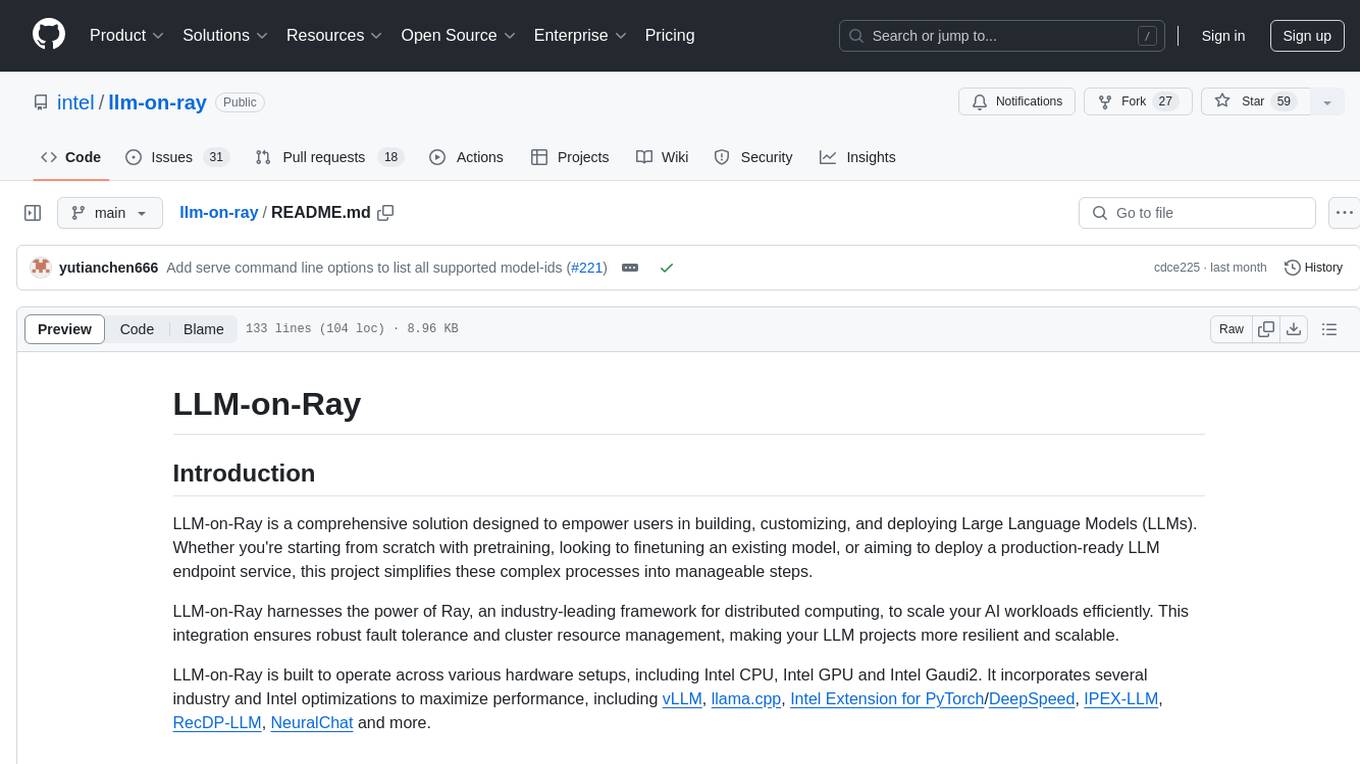
LLM-on-Ray is a comprehensive solution for building, customizing, and deploying Large Language Models (LLMs). It simplifies complex processes into manageable steps by leveraging the power of Ray for distributed computing. The tool supports pretraining, finetuning, and serving LLMs across various hardware setups, incorporating industry and Intel optimizations for performance. It offers modular workflows with intuitive configurations, robust fault tolerance, and scalability. Additionally, it provides an Interactive Web UI for enhanced usability, including a chatbot application for testing and refining models.
README:
LLM-on-Ray is a comprehensive solution designed to empower users in building, customizing, and deploying Large Language Models (LLMs). Whether you're starting from scratch with pretraining, looking to finetuning an existing model, or aiming to deploy a production-ready LLM endpoint service, this project simplifies these complex processes into manageable steps.
LLM-on-Ray harnesses the power of Ray, an industry-leading framework for distributed computing, to scale your AI workloads efficiently. This integration ensures robust fault tolerance and cluster resource management, making your LLM projects more resilient and scalable.
LLM-on-Ray is built to operate across various hardware setups, including Intel CPU, Intel GPU and Intel Gaudi2. It incorporates several industry and Intel optimizations to maximize performance, including vLLM, llama.cpp, Intel Extension for PyTorch/DeepSpeed, IPEX-LLM, RecDP-LLM, NeuralChat and more.
LLM-on-Ray's modular workflow structure is designed to comprehensively cater to the various stages of LLM development, from pretraining and finetuning to serving. These workflows are intuitive, highly configurable, and tailored to meet the specific needs of each phase in the LLM lifecycle:
-
Pretraining Workflow: Provides the infrastructure to build LLMs from scratch.
- Data Preparation: Includes a suite of tools for preparing your training data which facilitate tasks like the removal of Personally Identifiable Information (PII), data deduplication (Dedup), and other preprocessing needs, making the data safe and efficient for training.
- Megatron-DeepSpeed Integration: Leverages the power of Megatron-DeepSpeed to enable advanced capabilities such as pipeline parallelism, tensor parallelism, data parallelism, and Zero Redundancy Optimizer (ZeRO). This integration facilitates efficient and scalable model training from the ground up.
- Robust Fault Tolerance: Offers automatic fault tolerance powered by Ray. This ensures high availability, reliability, and optimal performance for large scale pretraining.
-
Finetuning Workflow: Supports refinement of pre-trained models with proprietary or specialized data, improving models' accuracy and applicability to various use cases.
- Ease of Customization: Users can easily configure the base model and resource allocation for the training job, customize training parameters to fit their specific needs. This can be accomplished through a simple command line or via the Web UI.
- Parameter Efficient Finetuning: Supports various parameter efficient finetuning methods such as LoRA to accelerate the finetuning process.
- Reinforcement Learning with Human Feedback (RLHF): Users can further refine the model using RLHF, which leverages the proximal policy optimization (PPO).
-
Serving Workflow: Deploys a scalable and production-ready LLM serving endpoint.
- Easy Deployment of Models: Supports the deployment of both widely-used open-source models and custom finetuned models through flexible configurations.
- Autoscaling and Scale-to-Zero Capabilities: Ensures high efficiency and cost-effectiveness in model deployment. The workflow can dynamically scale resources to match demand and scale down to zero when the model is not in use, optimizing resource usage and reducing operational costs.
- Optimized for Performance and Efficiency: LLM-on-Ray incorporates several optimizations to maximize performance. This includes support for various precision levels and the utilization of advanced optimization techniques from Intel, ensuring efficient processing and reduced resource consumption.
- OpenAI-Like REST API: Provides APIs similar to OpenAI's, making it easier for users to transition to or integrate open-source models into their systems.
-
Interactive Web UI for Enhanced Usability: Except for command line, LLM-on-Ray introduces a Web UI, allowing users to easily finetune and deploy LLMs through a user-friendly interface. Additionally, the UI includes a chatbot application, enabling users to immediately test and refine the models.
This guide will assist you in setting up LLM-on-Ray on Intel CPU locally, covering the initial setup, finetuning models, and deploying them for serving.
Software requirement: Git and Conda
git clone https://github.com/intel/llm-on-ray.git
cd llm-on-ray
conda create -n llm-on-ray python=3.9
conda activate llm-on-ray
pip install .[cpu] --extra-index-url https://download.pytorch.org/whl/cpu --extra-index-url https://pytorch-extension.intel.com/release-whl/stable/cpu/us/[Optional] If DeepSpeed is enabled or doing distributed finetuing, oneCCL and Intel MPI libraries should be dynamically linked in every node before Ray starts:
source $(python -c "import oneccl_bindings_for_pytorch as torch_ccl; print(torch_ccl.cwd)")/env/setvars.shStart Ray locally using the following command. To launch a Ray cluster, please follow the setup document.
ray start --headUse the following command to finetune a model using an example dataset and default configurations. The finetuned model will be stored in /tmp/llm-ray/output by default. To customize the base model, dataset and configurations, please see the finetuning document:
llm_on_ray-finetune --config_file llm_on_ray/finetune/finetune.yamlDeploy a model on Ray and expose an endpoint for serving. This command uses GPT2 as an example, but more model configuration examples can be found in the inference/models directory:
llm_on_ray-serve --config_file llm_on_ray/inference/models/gpt2.yamlYou can also use model_ids to serve directly through:
llm_on_ray-serve --models gpt2List all support model_ids with config file path:
llm_on_ray-serve --list_model_idsThe default served method is to provide an OpenAI-compatible API server (OpenAI API Reference), you can access and test it in many ways:
# using curl
export ENDPOINT_URL=http://localhost:8000/v1
curl $ENDPOINT_URL/chat/completions \
-H "Content-Type: application/json" \
-d '{
"model": "gpt2",
"messages": [{"role": "system", "content": "You are a helpful assistant."}, {"role": "user", "content": "Hello!"}],
"temperature": 0.7
}'
# using requests library
python examples/inference/api_server_openai/query_http_requests.py
# using OpenAI SDK
pip install openai>=1.0
export OPENAI_BASE_URL=http://localhost:8000/v1
export OPENAI_API_KEY="not_a_real_key"
python examples/inference/api_server_openai/query_openai_sdk.pyOr you can serve specific model to a simple endpoint according to the port and route_prefix parameters in configuration file,
llm_on_ray-serve --config_file llm_on_ray/inference/models/gpt2.yaml --simpleAfter deploying the model endpoint, you can access and test it by using the script below:
python examples/inference/api_server_simple/query_single.py --model_endpoint http://127.0.0.1:8000/gpt2This guide will assist you in setting up LLM-on-Ray on With Docker.
git clone https://github.com/intel/llm-on-ray.git
cd llm-on-rayThe dockerfile for user is in dev/docker/Dockerfile.user.
Detailed parameter can be set up for docker in dev/scripts/docker-functions.sh.
source dev/scripts/docker-functions.shDefault cpu and deepspeed for llm serving.
build_docker Change build_docker fuction's args for different environment.
Use vllm for llm serving.
build_docker vllm Use ipex-vllm for llm serving.
build_docker ipex-llm Change any settings in dev/scripts/docker-functions.sh.
Run docker with cpu and gpt2 serving.
start_dockerRun docker with cpu and other support models serving.
start_docker llama-2-7b-chat-hfRun docker with different environment and other models start_docker {environment} {models} like:
start_docker vllm llama-2-7b-chat-hfThe model serving port in docker container has been mapped to local.
Using requests library.
python examples/inference/api_server_openai/query_http_requests.pyUsing OpenAI SDK
python examples/inference/api_server_openai/query_openai_sdk.pyThe following are detailed guidelines for pretraining, finetuning and serving LLMs in various computing environment.
- Deploy and Serve LLMs on Intel CPU/GPU/Gaudi
- Deploy and Serve LLMs with DeepSpeed
- Deploy and Serve LLMs with IPEX-LLM
To the extent that any public datasets are referenced by Intel or accessed using tools or code on this site those datasets are provided by the third party indicated as the data source. Intel does not create the data, or datasets, and does not warrant their accuracy or quality. By accessing the public dataset(s), or using a model trained on those datasets, you agree to the terms associated with those datasets and that your use complies with the applicable license.
Intel expressly disclaims the accuracy, adequacy, or completeness of any public datasets, and is not liable for any errors, omissions, or defects in the data, or for any reliance on the data. Intel is not liable for any liability or damages relating to your use of public datasets.
For Tasks:
Click tags to check more tools for each tasksFor Jobs:
Alternative AI tools for llm-on-ray
Similar Open Source Tools

llm-on-ray
LLM-on-Ray is a comprehensive solution for building, customizing, and deploying Large Language Models (LLMs). It simplifies complex processes into manageable steps by leveraging the power of Ray for distributed computing. The tool supports pretraining, finetuning, and serving LLMs across various hardware setups, incorporating industry and Intel optimizations for performance. It offers modular workflows with intuitive configurations, robust fault tolerance, and scalability. Additionally, it provides an Interactive Web UI for enhanced usability, including a chatbot application for testing and refining models.
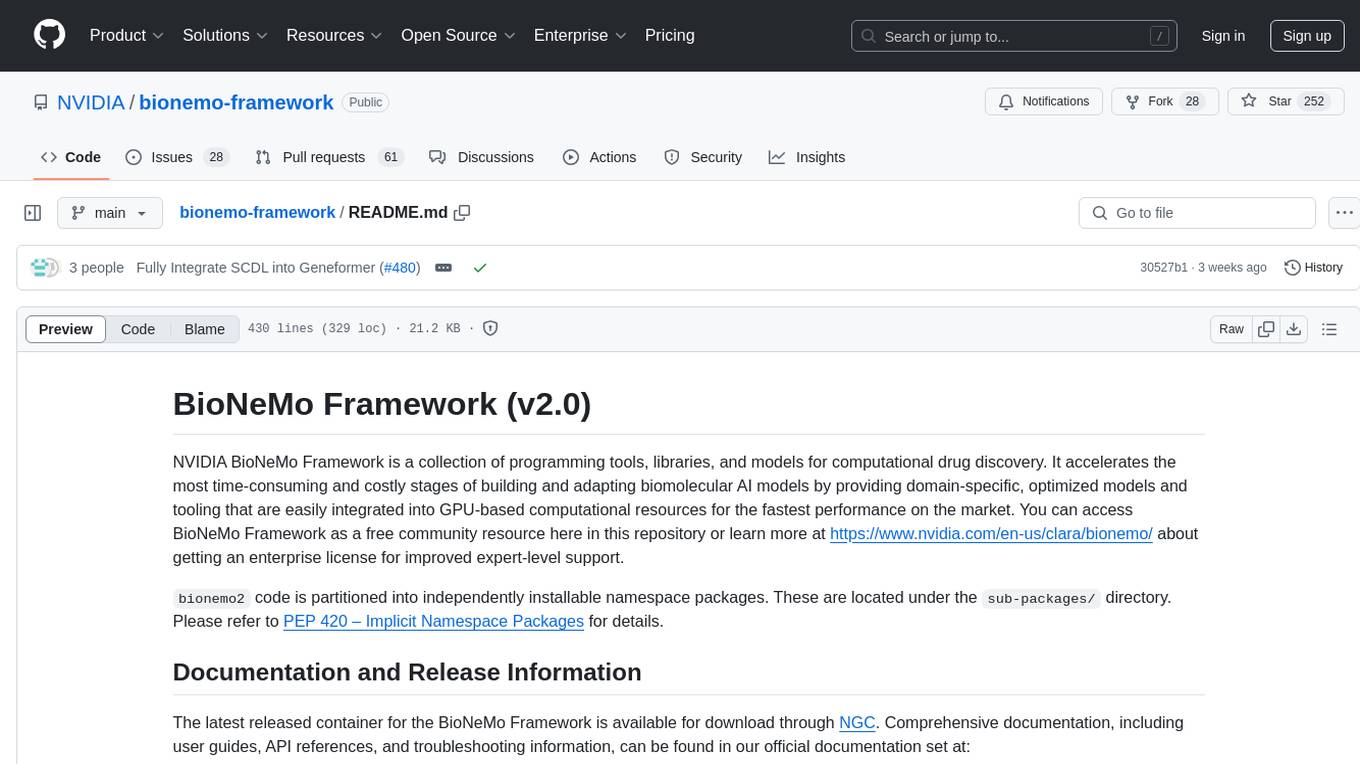
bionemo-framework
NVIDIA BioNeMo Framework is a collection of programming tools, libraries, and models for computational drug discovery. It accelerates building and adapting biomolecular AI models by providing domain-specific, optimized models and tooling for GPU-based computational resources. The framework offers comprehensive documentation and support for both community and enterprise users.
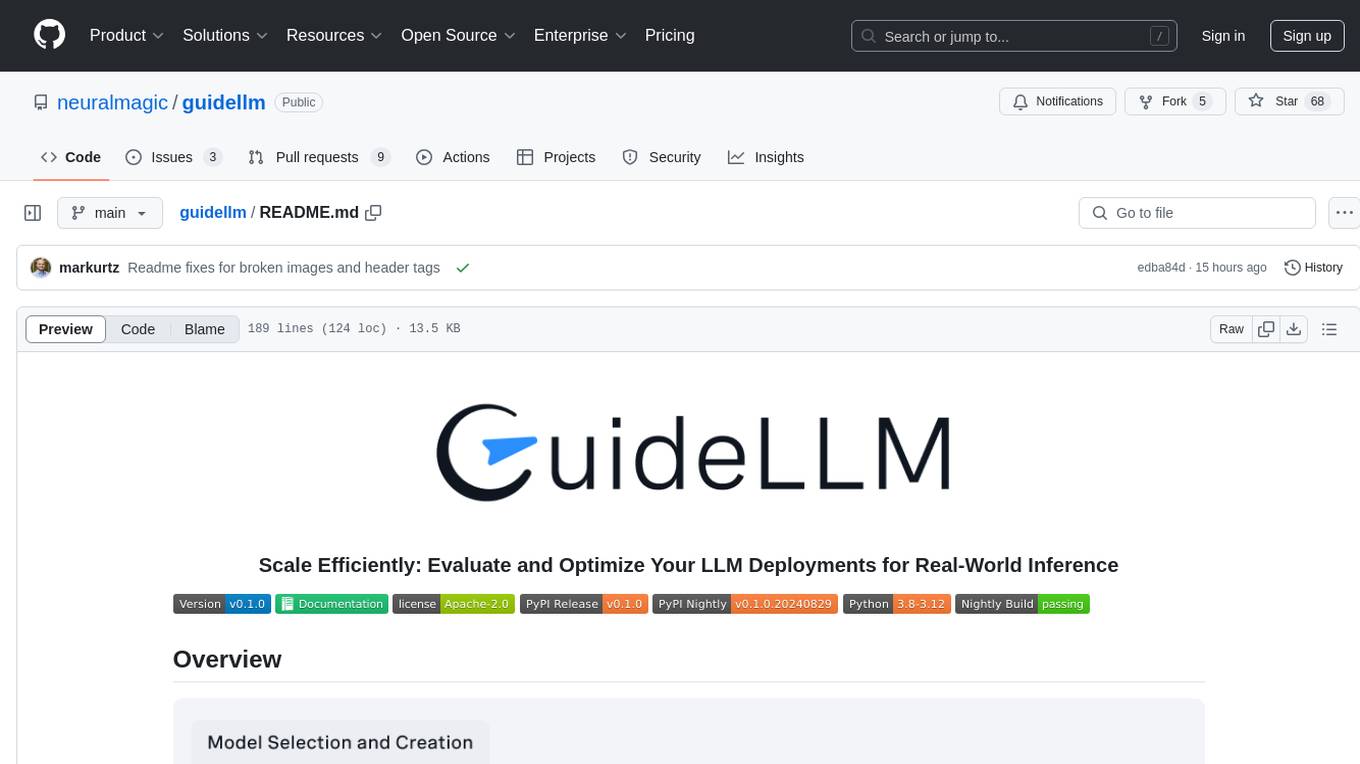
guidellm
GuideLLM is a powerful tool for evaluating and optimizing the deployment of large language models (LLMs). By simulating real-world inference workloads, GuideLLM helps users gauge the performance, resource needs, and cost implications of deploying LLMs on various hardware configurations. This approach ensures efficient, scalable, and cost-effective LLM inference serving while maintaining high service quality. Key features include performance evaluation, resource optimization, cost estimation, and scalability testing.
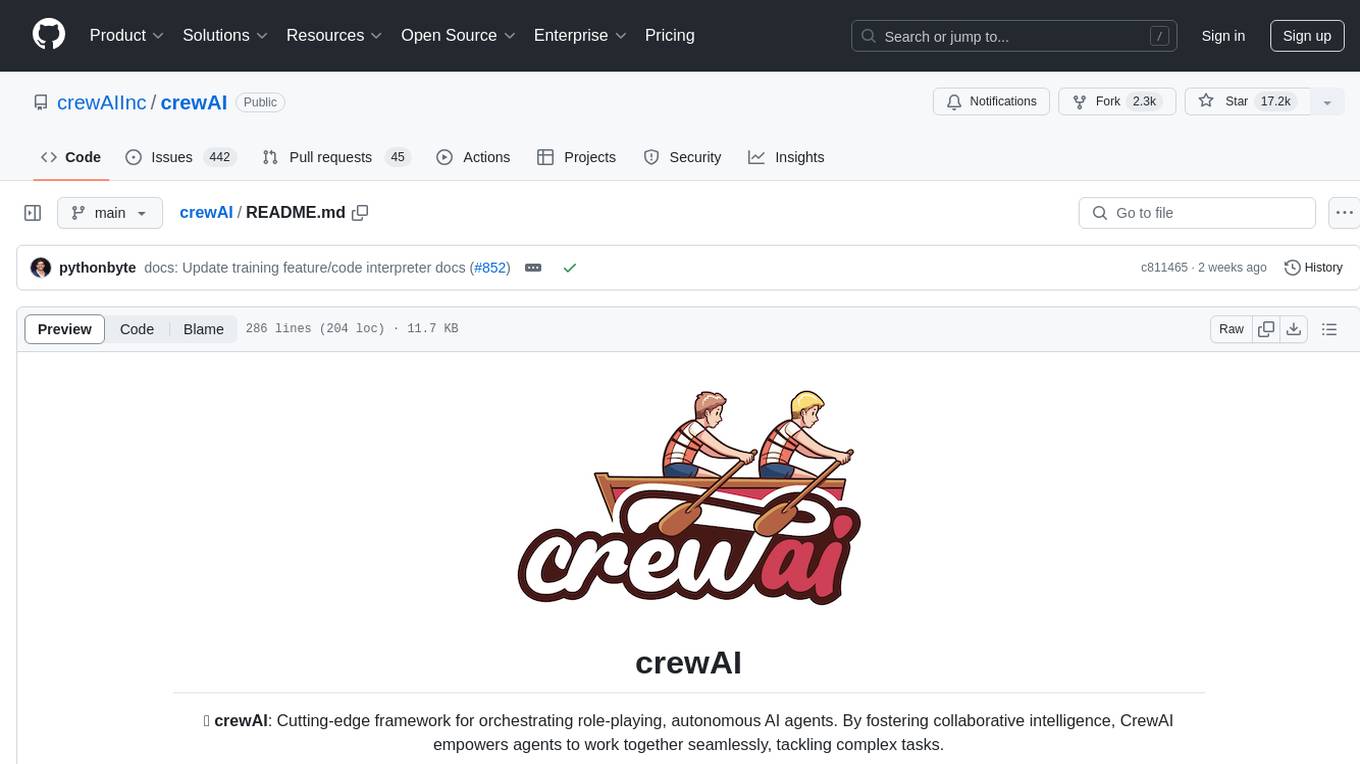
crewAI
CrewAI is a cutting-edge framework designed to orchestrate role-playing autonomous AI agents. By fostering collaborative intelligence, CrewAI empowers agents to work together seamlessly, tackling complex tasks. It enables AI agents to assume roles, share goals, and operate in a cohesive unit, much like a well-oiled crew. Whether you're building a smart assistant platform, an automated customer service ensemble, or a multi-agent research team, CrewAI provides the backbone for sophisticated multi-agent interactions. With features like role-based agent design, autonomous inter-agent delegation, flexible task management, and support for various LLMs, CrewAI offers a dynamic and adaptable solution for both development and production workflows.
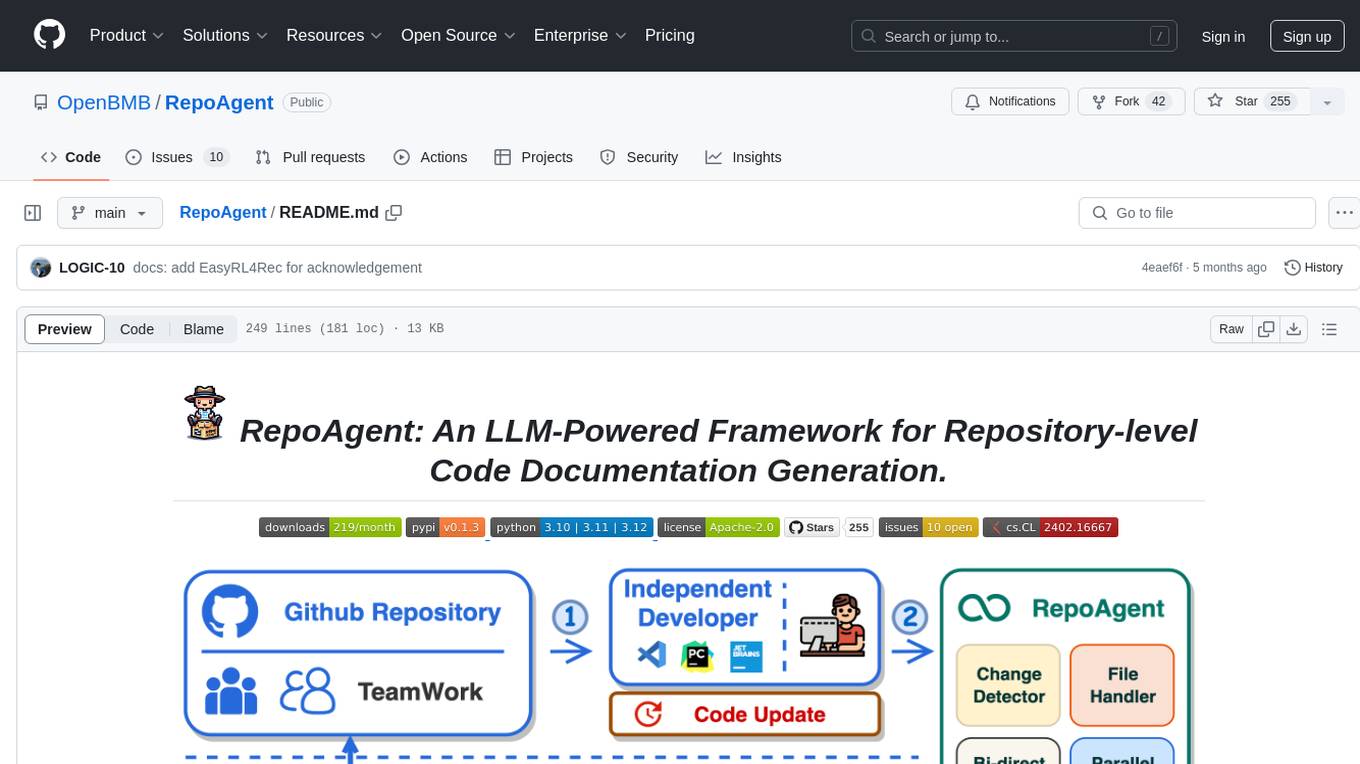
RepoAgent
RepoAgent is an LLM-powered framework designed for repository-level code documentation generation. It automates the process of detecting changes in Git repositories, analyzing code structure through AST, identifying inter-object relationships, replacing Markdown content, and executing multi-threaded operations. The tool aims to assist developers in understanding and maintaining codebases by providing comprehensive documentation, ultimately improving efficiency and saving time.
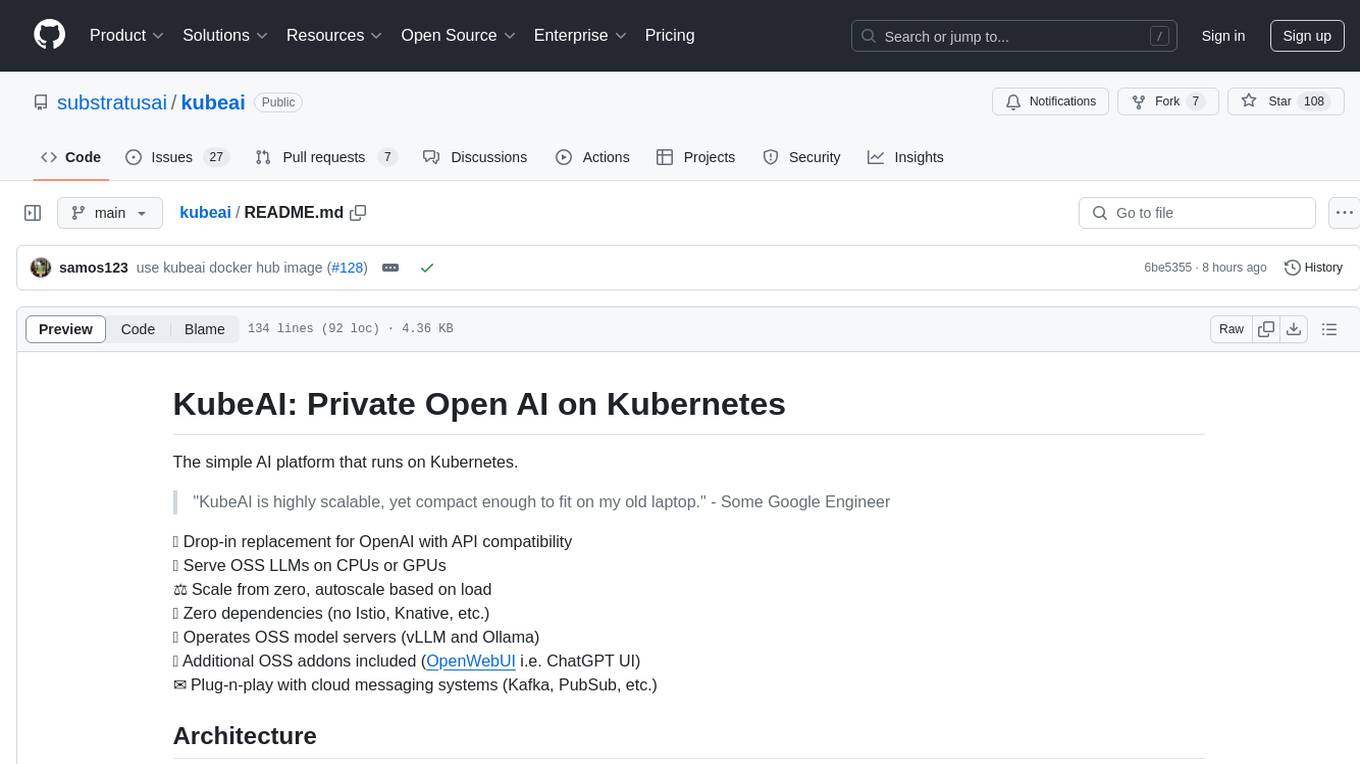
kubeai
KubeAI is a highly scalable AI platform that runs on Kubernetes, serving as a drop-in replacement for OpenAI with API compatibility. It can operate OSS model servers like vLLM and Ollama, with zero dependencies and additional OSS addons included. Users can configure models via Kubernetes Custom Resources and interact with models through a chat UI. KubeAI supports serving various models like Llama v3.1, Gemma2, and Qwen2, and has plans for model caching, LoRA finetuning, and image generation.
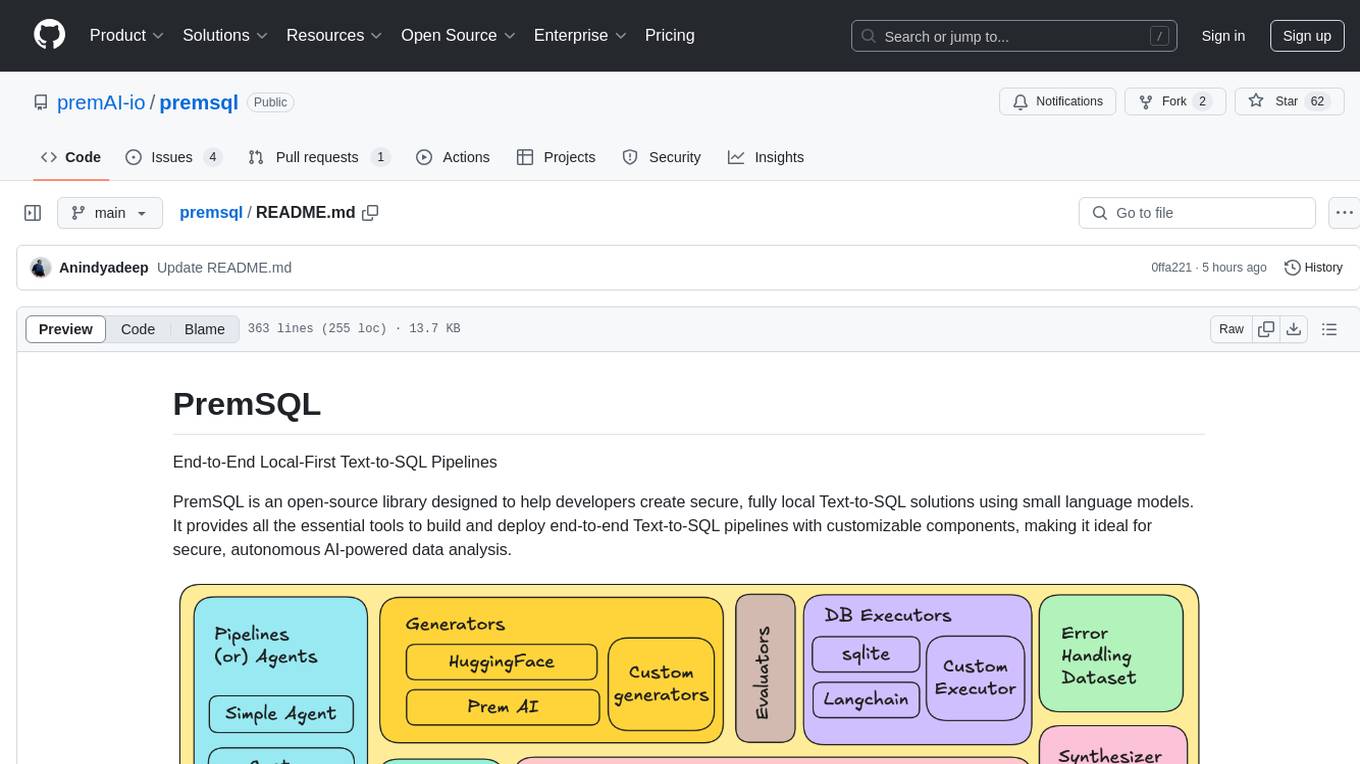
premsql
PremSQL is an open-source library designed to help developers create secure, fully local Text-to-SQL solutions using small language models. It provides essential tools for building and deploying end-to-end Text-to-SQL pipelines with customizable components, ideal for secure, autonomous AI-powered data analysis. The library offers features like Local-First approach, Customizable Datasets, Robust Executors and Evaluators, Advanced Generators, Error Handling and Self-Correction, Fine-Tuning Support, and End-to-End Pipelines. Users can fine-tune models, generate SQL queries from natural language inputs, handle errors, and evaluate model performance against predefined metrics. PremSQL is extendible for customization and private data usage.
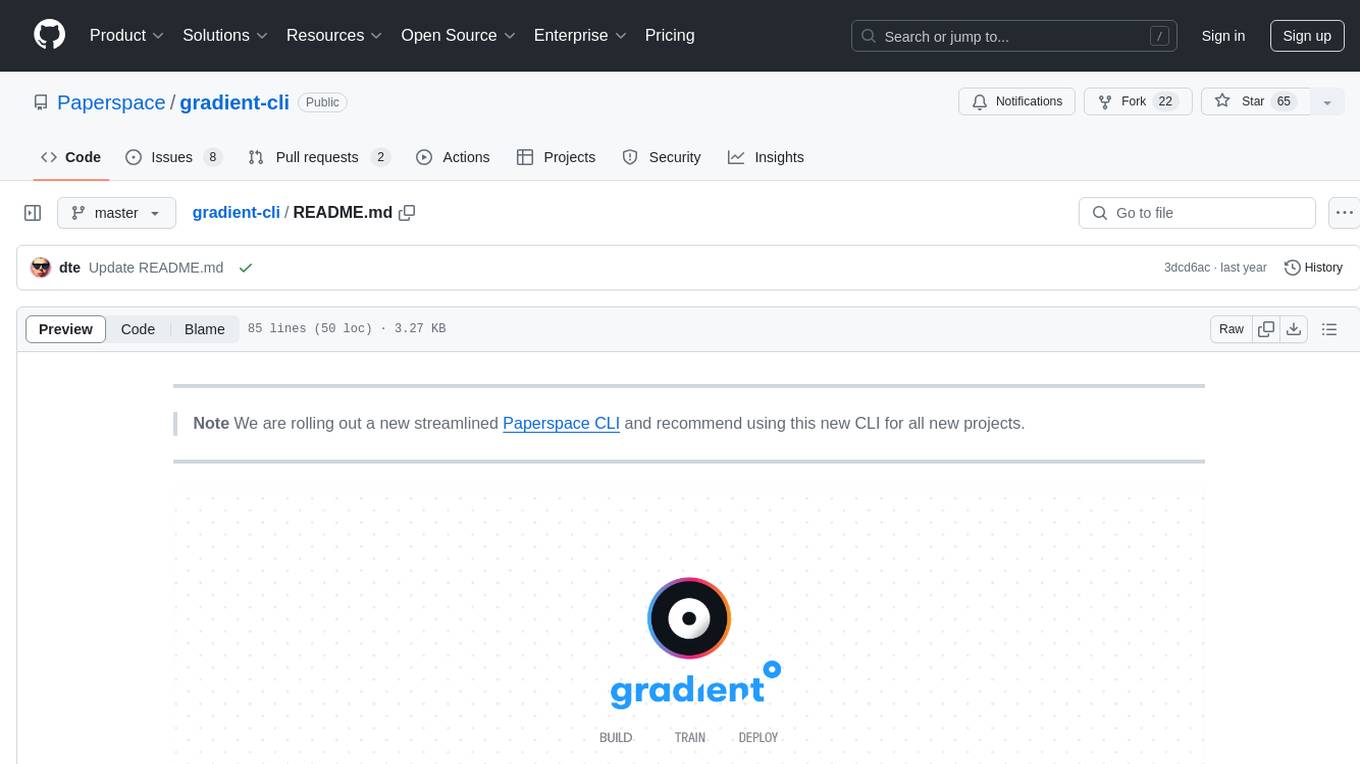
gradient-cli
Gradient CLI is a tool designed to facilitate the end-to-end MLOps process, allowing individuals and organizations to develop, train, and deploy Deep Learning models efficiently. It supports various ML/DL frameworks and provides features such as 1-click Jupyter Notebooks, scalable model training workflows, and model deployment as API endpoints. The tool can run on different infrastructures like AWS, GCP, on-premise, and Paperspace GPUs, offering automatic versioning, distributed training, hyperparameter search, and more.
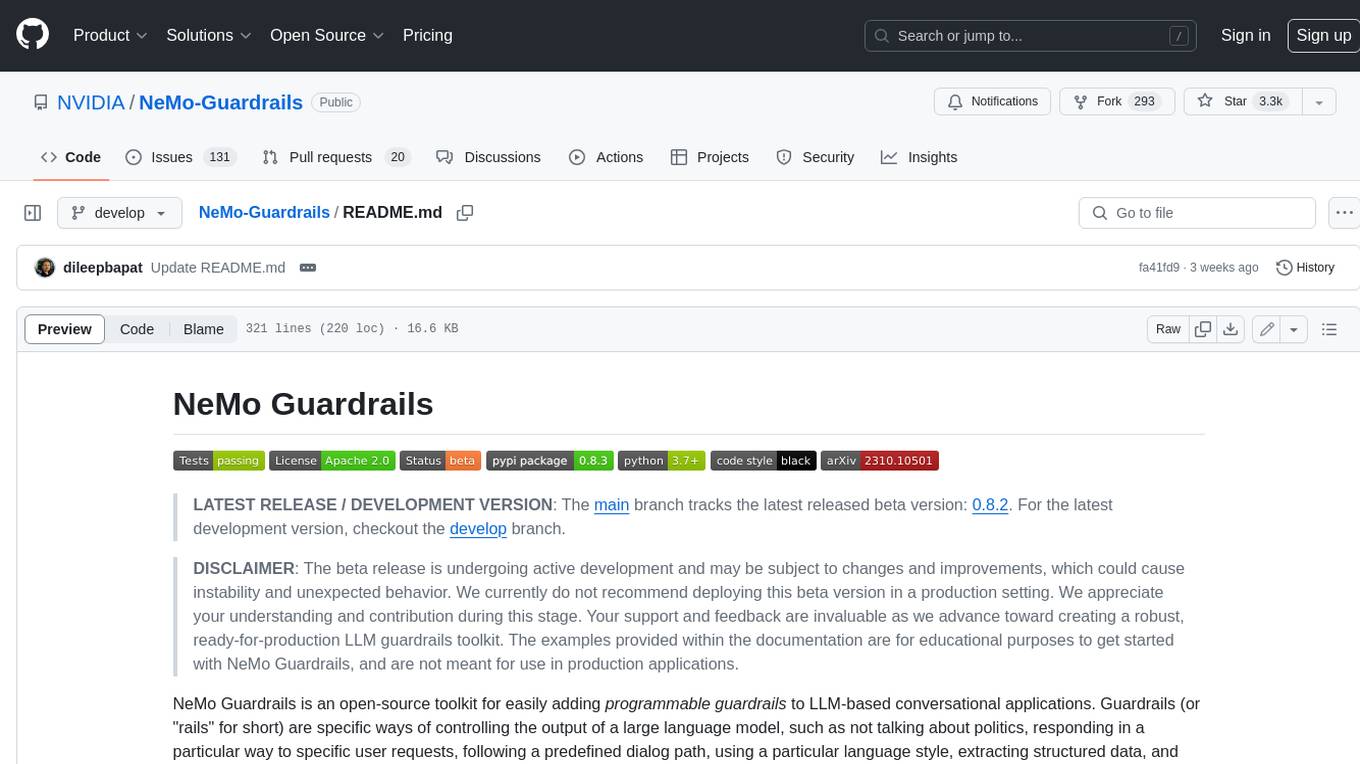
Guardrails
Guardrails is a security tool designed to help developers identify and fix security vulnerabilities in their code. It provides automated scanning and analysis of code repositories to detect potential security issues, such as sensitive data exposure, injection attacks, and insecure configurations. By integrating Guardrails into the development workflow, teams can proactively address security concerns and reduce the risk of security breaches. The tool offers detailed reports and actionable recommendations to guide developers in remediation efforts, ultimately improving the overall security posture of the codebase. Guardrails supports multiple programming languages and frameworks, making it versatile and adaptable to different development environments. With its user-friendly interface and seamless integration with popular version control systems, Guardrails empowers developers to prioritize security without compromising productivity.
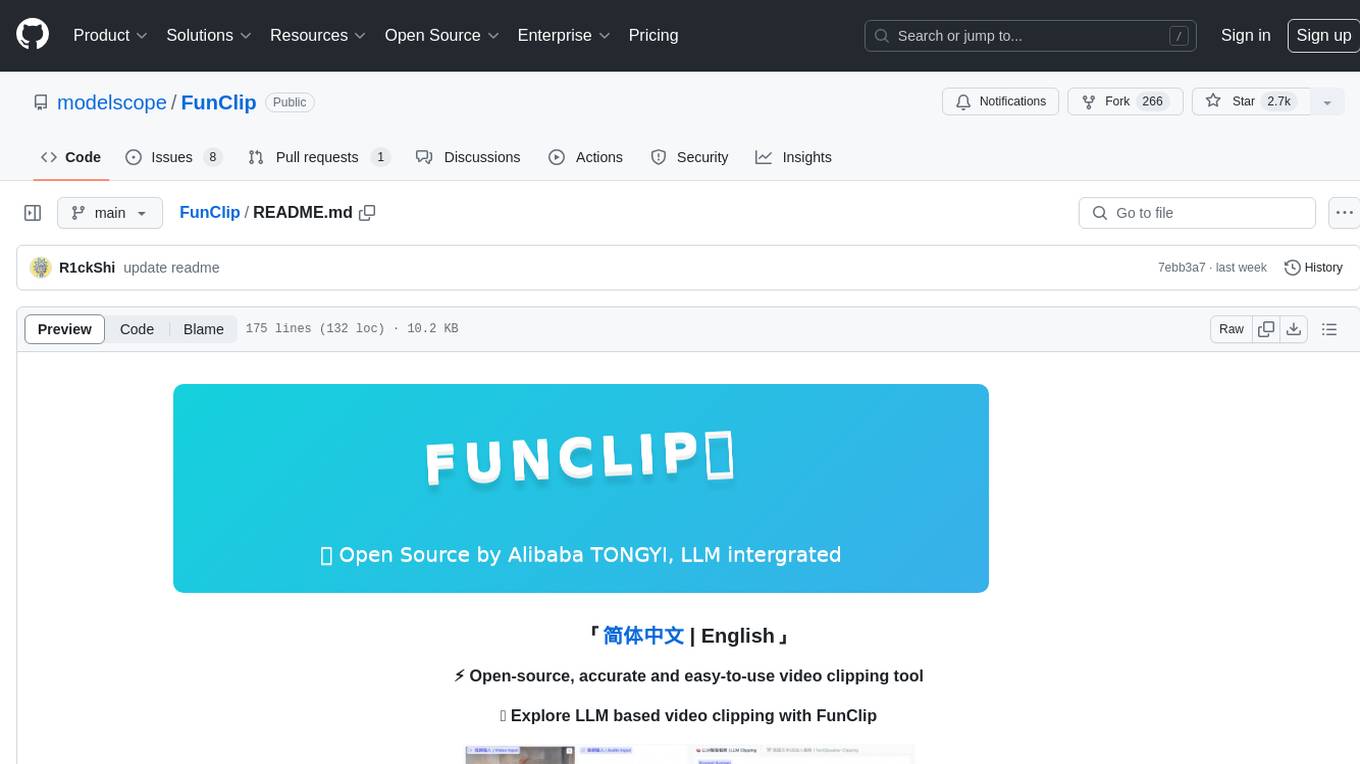
FunClip
FunClip is an open-source, locally deployed automated video clipping tool that leverages Alibaba TONGYI speech lab's FunASR Paraformer series models for speech recognition on videos. Users can select text segments or speakers from recognition results to obtain corresponding video clips. It integrates industrial-grade models for accurate predictions and offers hotword customization and speaker recognition features. The tool is user-friendly with Gradio interaction, supporting multi-segment clipping and providing full video and target segment subtitles. FunClip is suitable for users looking to automate video clipping tasks with advanced AI capabilities.
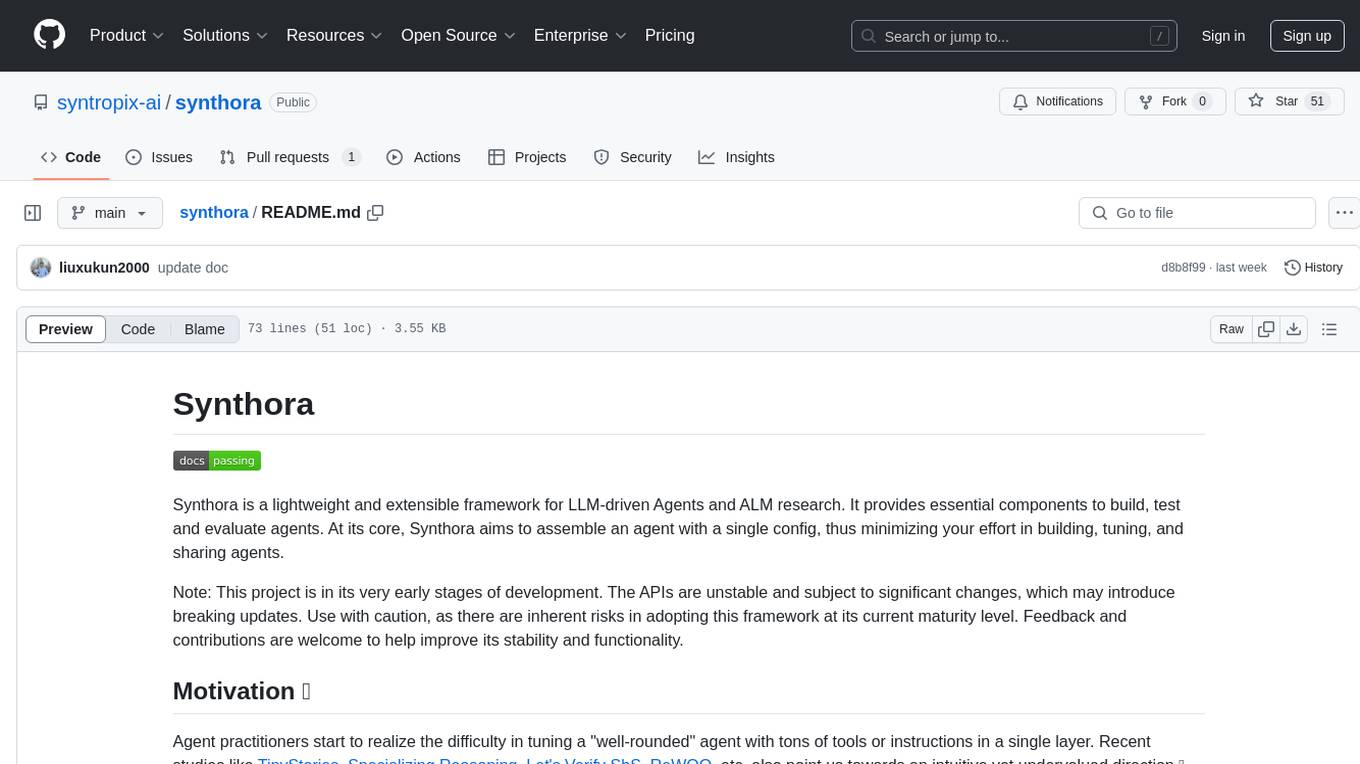
synthora
Synthora is a lightweight and extensible framework for LLM-driven Agents and ALM research. It aims to simplify the process of building, testing, and evaluating agents by providing essential components. The framework allows for easy agent assembly with a single config, reducing the effort required for tuning and sharing agents. Although in early development stages with unstable APIs, Synthora welcomes feedback and contributions to enhance its stability and functionality.
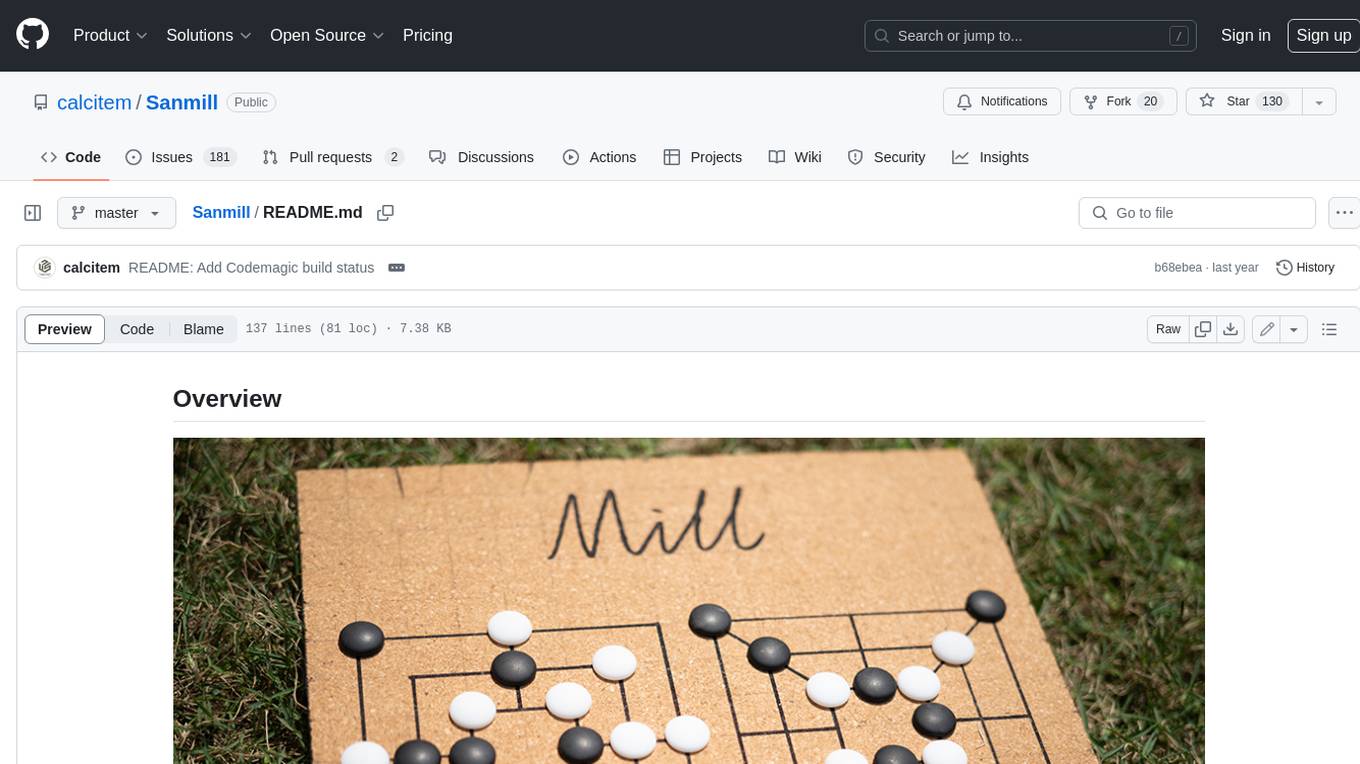
Sanmill
Sanmill is a free, powerful UCI-like N men's morris program with CUI, Flutter GUI and Qt GUI. Nine men's morris is a strategy board game for two players dating at least to the Roman Empire. The game is also known as nine-man morris , mill , mills , the mill game , merels , merrills , merelles , marelles , morelles , and ninepenny marl in English.

kaito
Kaito is an operator that automates the AI/ML inference model deployment in a Kubernetes cluster. It manages large model files using container images, avoids tuning deployment parameters to fit GPU hardware by providing preset configurations, auto-provisions GPU nodes based on model requirements, and hosts large model images in the public Microsoft Container Registry (MCR) if the license allows. Using Kaito, the workflow of onboarding large AI inference models in Kubernetes is largely simplified.
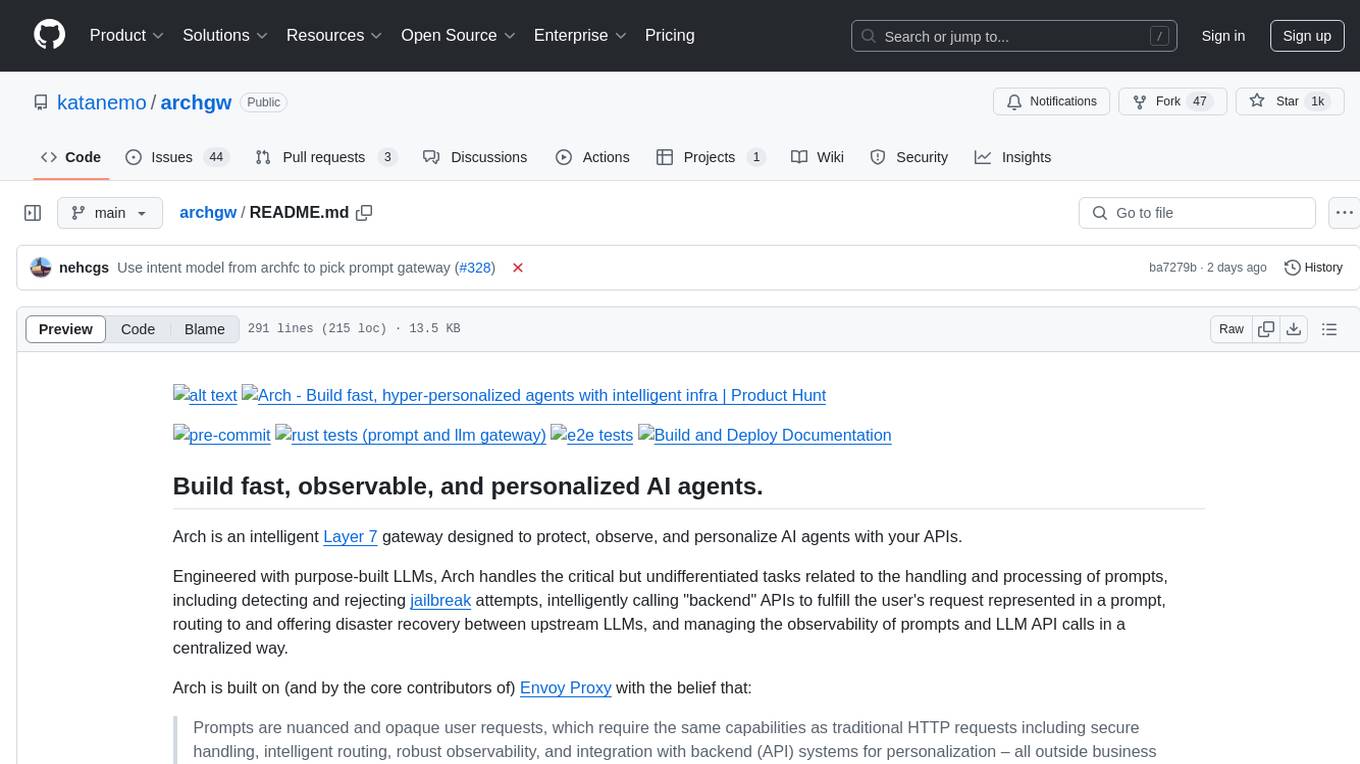
archgw
Arch is an intelligent Layer 7 gateway designed to protect, observe, and personalize AI agents with APIs. It handles tasks related to prompts, including detecting jailbreak attempts, calling backend APIs, routing between LLMs, and managing observability. Built on Envoy Proxy, it offers features like function calling, prompt guardrails, traffic management, and observability. Users can build fast, observable, and personalized AI agents using Arch to improve speed, security, and personalization of GenAI apps.

labelbox-python
Labelbox is a data-centric AI platform for enterprises to develop, optimize, and use AI to solve problems and power new products and services. Enterprises use Labelbox to curate data, generate high-quality human feedback data for computer vision and LLMs, evaluate model performance, and automate tasks by combining AI and human-centric workflows. The academic & research community uses Labelbox for cutting-edge AI research.
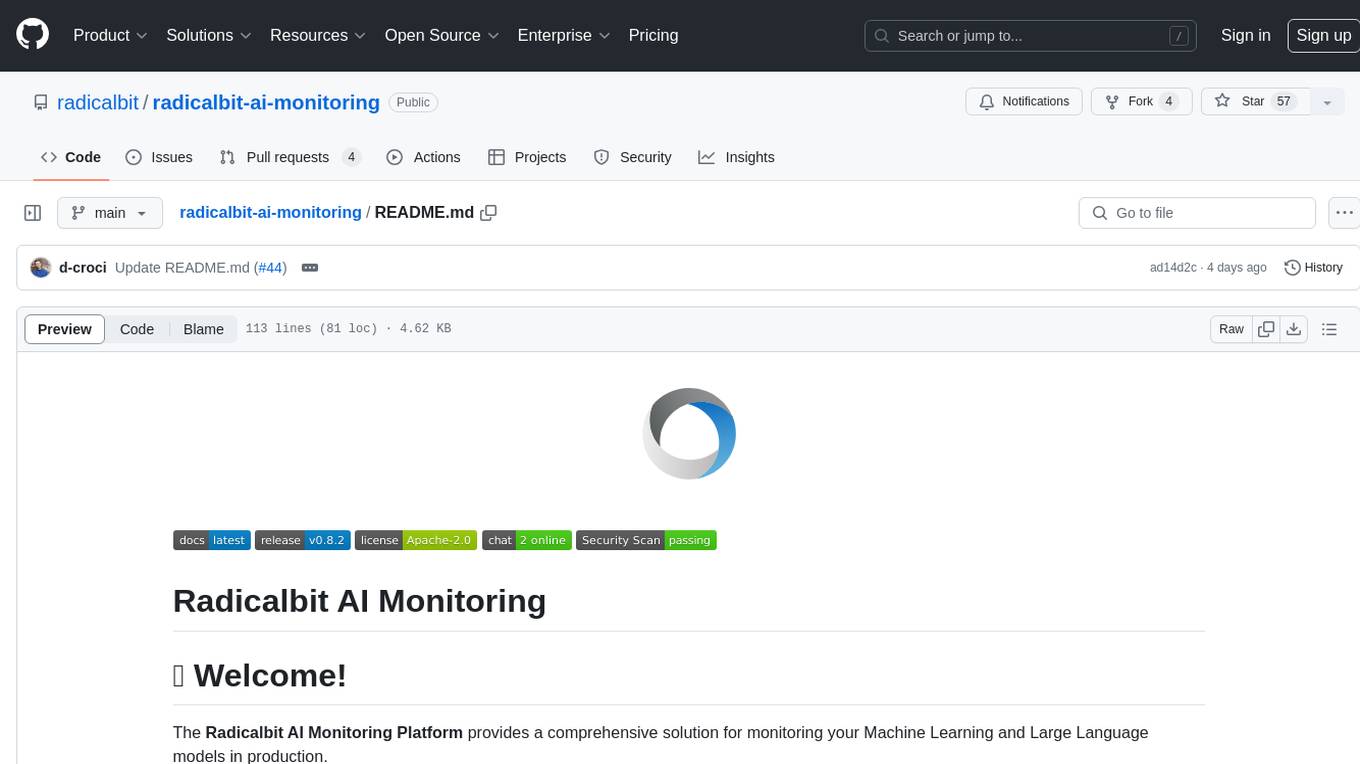
radicalbit-ai-monitoring
The Radicalbit AI Monitoring Platform provides a comprehensive solution for monitoring Machine Learning and Large Language models in production. It helps proactively identify and address potential performance issues by analyzing data quality, model quality, and model drift. The repository contains files and projects for running the platform, including UI, API, SDK, and Spark components. Installation using Docker compose is provided, allowing deployment with a K3s cluster and interaction with a k9s container. The platform documentation includes a step-by-step guide for installation and creating dashboards. Community engagement is encouraged through a Discord server. The roadmap includes adding functionalities for batch and real-time workloads, covering various model types and tasks.
For similar tasks

cria
Cria is a Python library designed for running Large Language Models with minimal configuration. It provides an easy and concise way to interact with LLMs, offering advanced features such as custom models, streams, message history management, and running multiple models in parallel. Cria simplifies the process of using LLMs by providing a straightforward API that requires only a few lines of code to get started. It also handles model installation automatically, making it efficient and user-friendly for various natural language processing tasks.
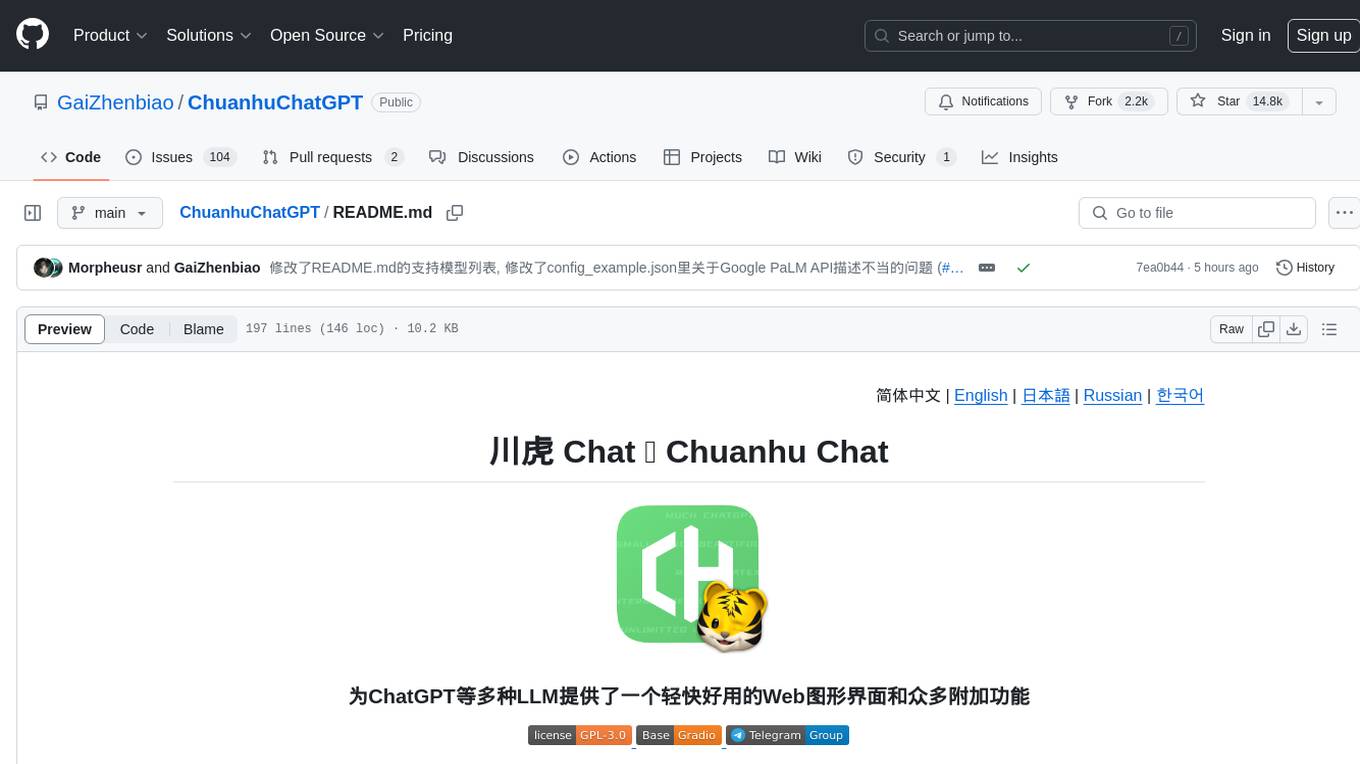
ChuanhuChatGPT
Chuanhu Chat is a user-friendly web graphical interface that provides various additional features for ChatGPT and other language models. It supports GPT-4, file-based question answering, local deployment of language models, online search, agent assistant, and fine-tuning. The tool offers a range of functionalities including auto-solving questions, online searching with network support, knowledge base for quick reading, local deployment of language models, GPT 3.5 fine-tuning, and custom model integration. It also features system prompts for effective role-playing, basic conversation capabilities with options to regenerate or delete dialogues, conversation history management with auto-saving and search functionalities, and a visually appealing user experience with themes, dark mode, LaTeX rendering, and PWA application support.
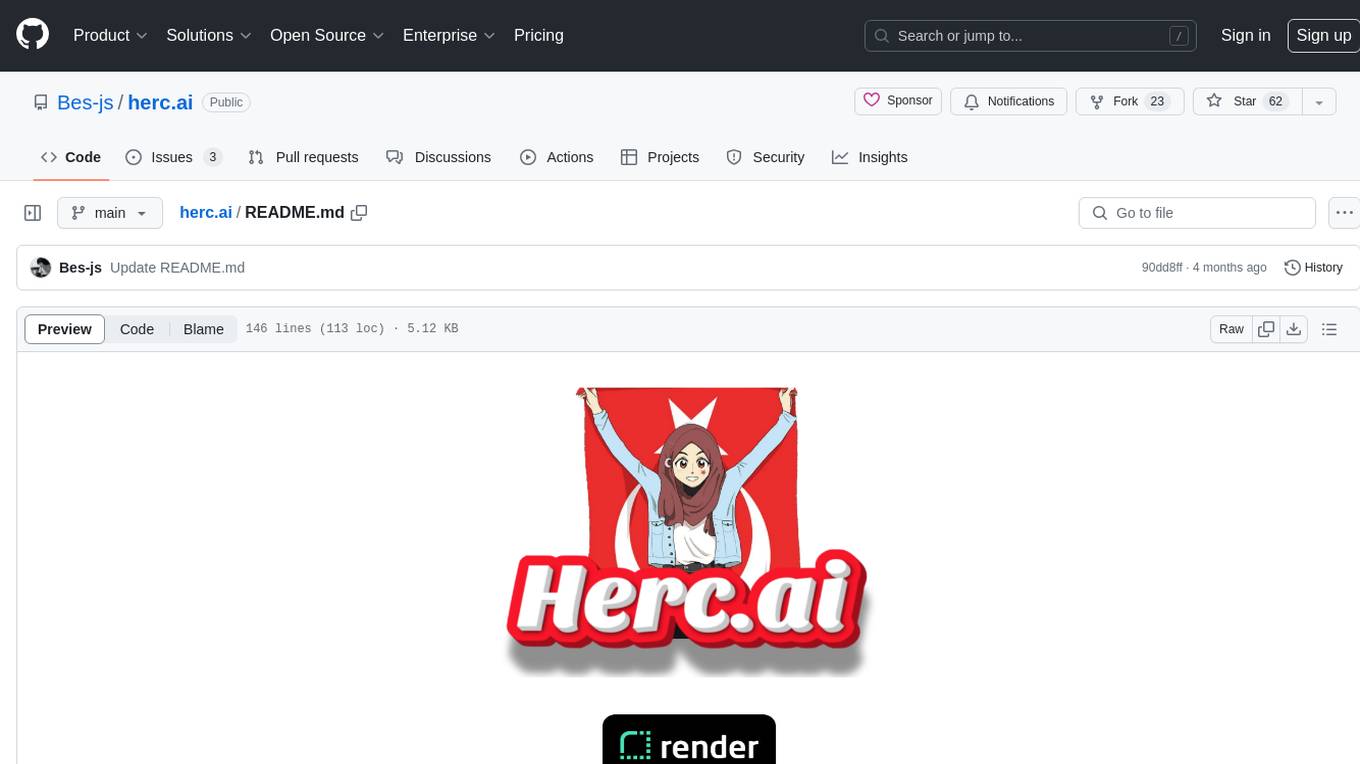
herc.ai
Herc.ai is a powerful library for interacting with the Herc.ai API. It offers free access to users and supports all languages. Users can benefit from Herc.ai's features unlimitedly with a one-time subscription and API key. The tool provides functionalities for question answering and text-to-image generation, with support for various models and customization options. Herc.ai can be easily integrated into CLI, CommonJS, TypeScript, and supports beta models for advanced usage. Developed by FiveSoBes and Luppux Development.
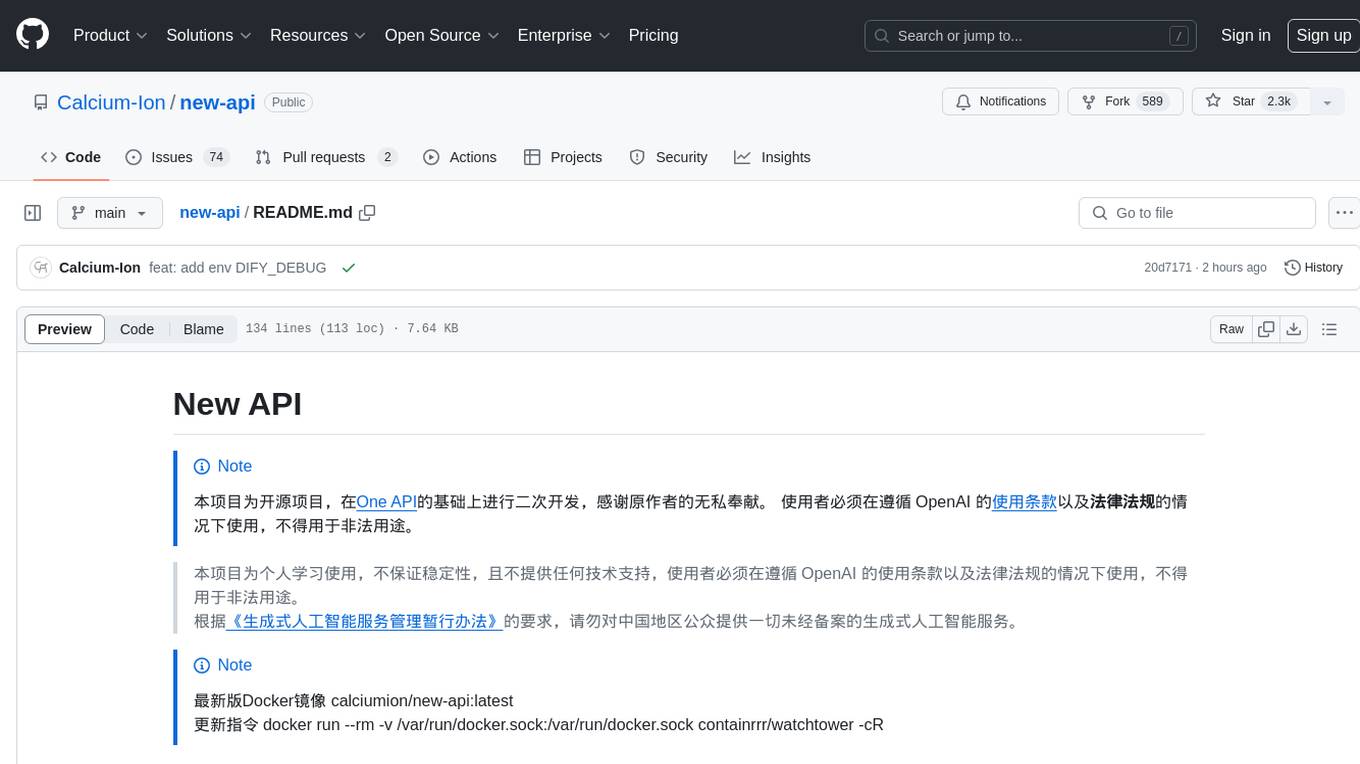
new-api
New API is an open-source project based on One API with additional features and improvements. It offers a new UI interface, supports Midjourney-Proxy(Plus) interface, online recharge functionality, model-based charging, channel weight randomization, data dashboard, token-controlled models, Telegram authorization login, Suno API support, Rerank model integration, and various third-party models. Users can customize models, retry channels, and configure caching settings. The deployment can be done using Docker with SQLite or MySQL databases. The project provides documentation for Midjourney and Suno interfaces, and it is suitable for AI enthusiasts and developers looking to enhance AI capabilities.
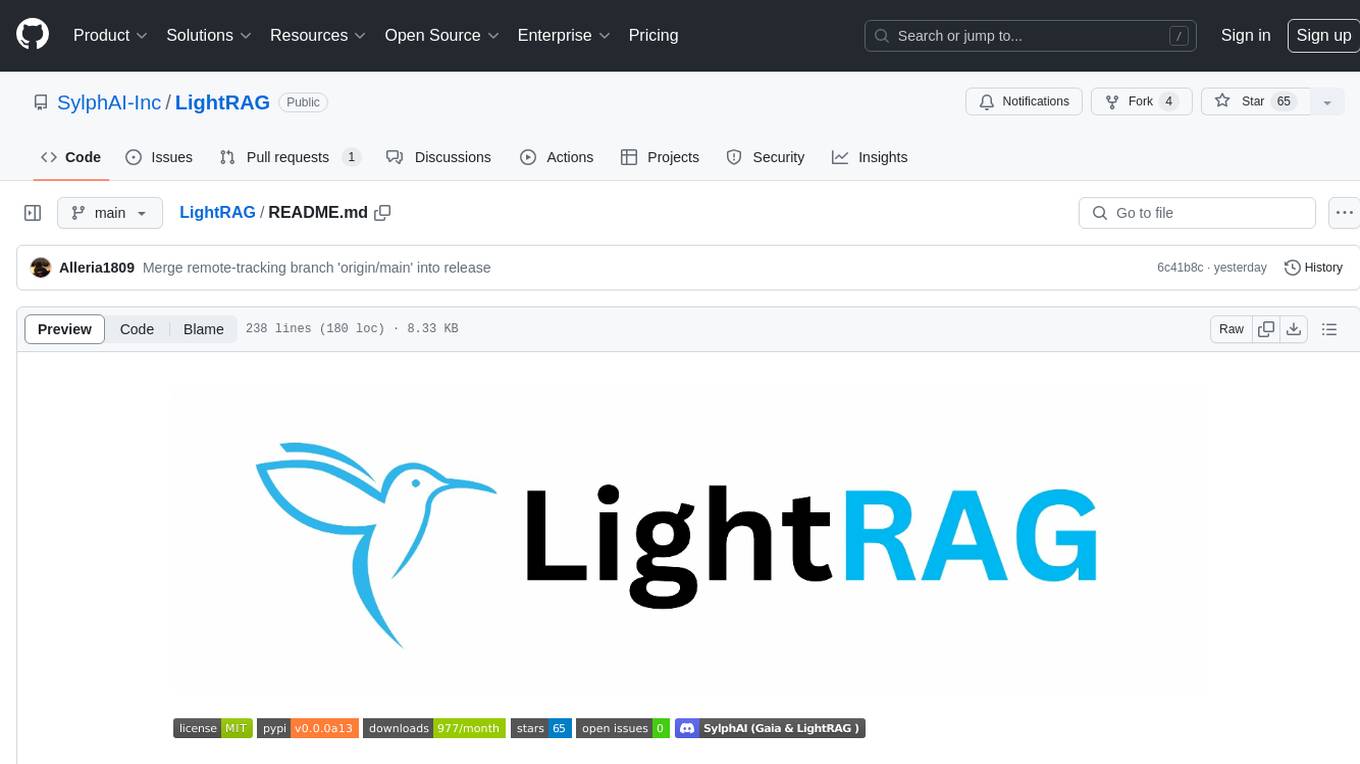
LightRAG
LightRAG is a PyTorch library designed for building and optimizing Retriever-Agent-Generator (RAG) pipelines. It follows principles of simplicity, quality, and optimization, offering developers maximum customizability with minimal abstraction. The library includes components for model interaction, output parsing, and structured data generation. LightRAG facilitates tasks like providing explanations and examples for concepts through a question-answering pipeline.

llm-on-ray
LLM-on-Ray is a comprehensive solution for building, customizing, and deploying Large Language Models (LLMs). It simplifies complex processes into manageable steps by leveraging the power of Ray for distributed computing. The tool supports pretraining, finetuning, and serving LLMs across various hardware setups, incorporating industry and Intel optimizations for performance. It offers modular workflows with intuitive configurations, robust fault tolerance, and scalability. Additionally, it provides an Interactive Web UI for enhanced usability, including a chatbot application for testing and refining models.
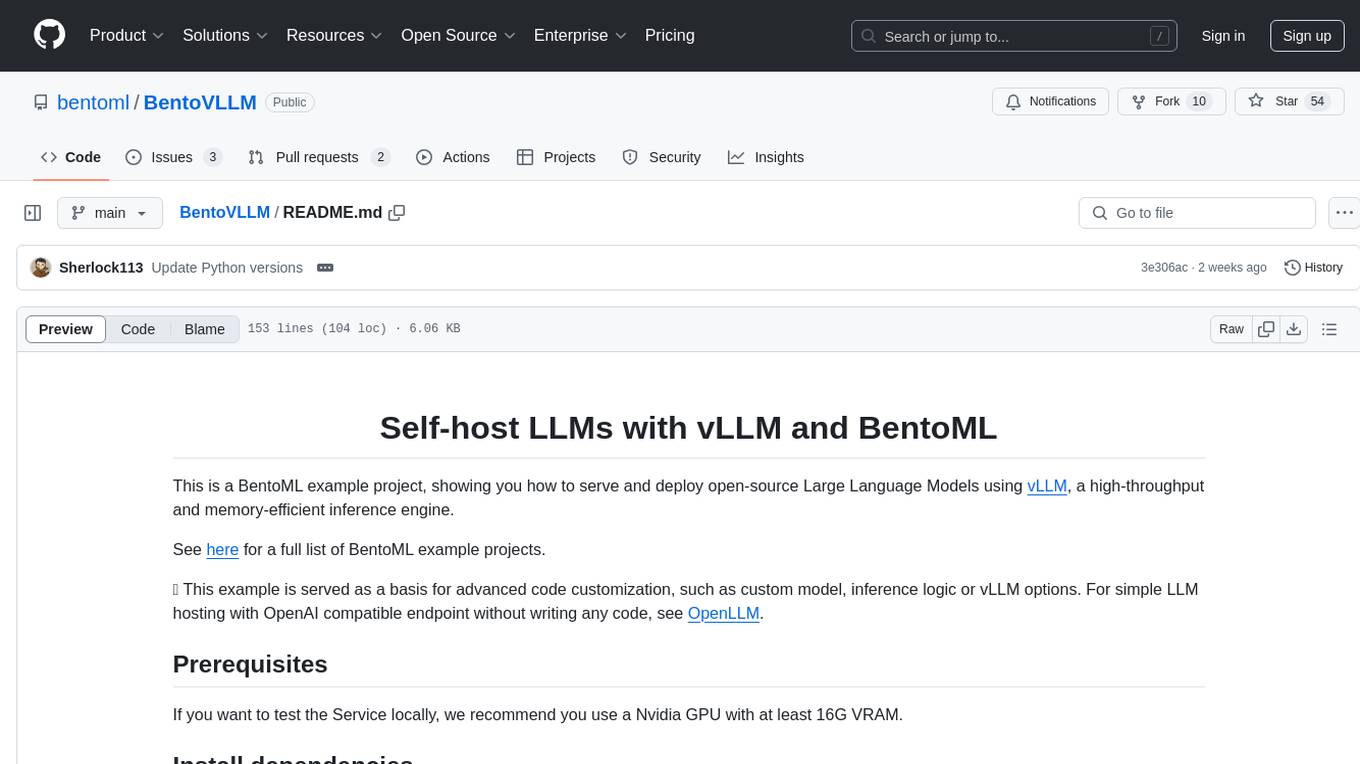
BentoVLLM
BentoVLLM is an example project demonstrating how to serve and deploy open-source Large Language Models using vLLM, a high-throughput and memory-efficient inference engine. It provides a basis for advanced code customization, such as custom models, inference logic, or vLLM options. The project allows for simple LLM hosting with OpenAI compatible endpoints without the need to write any code. Users can interact with the server using Swagger UI or other methods, and the service can be deployed to BentoCloud for better management and scalability. Additionally, the repository includes integration examples for different LLM models and tools.
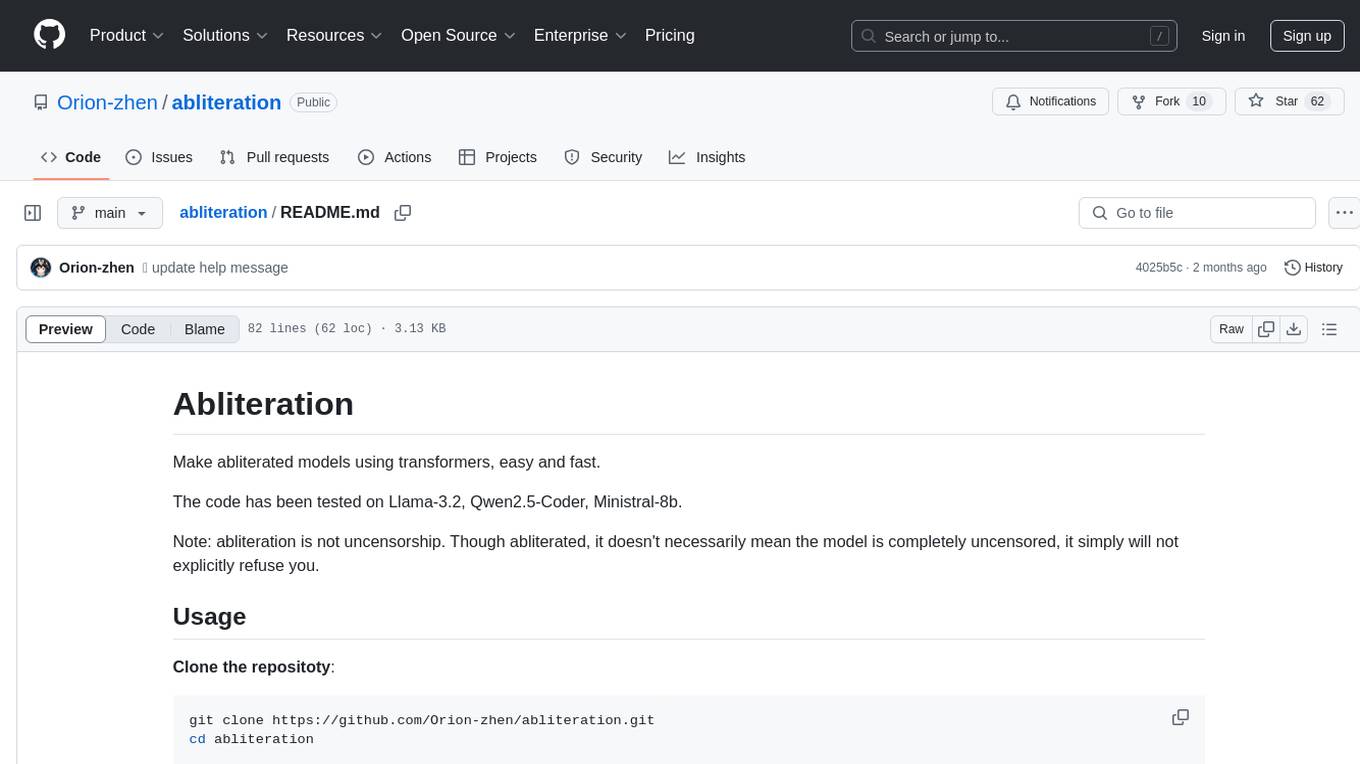
abliteration
Abliteration is a tool that allows users to create abliterated models using transformers quickly and easily. It is not a tool for uncensorship, but rather for making models that will not explicitly refuse users. Users can clone the repository, install dependencies, and make abliterations using the provided commands. The tool supports adjusting parameters for stubborn models and offers various options for customization. Abliteration can be used for creating modified models for specific tasks or topics.
For similar jobs

weave
Weave is a toolkit for developing Generative AI applications, built by Weights & Biases. With Weave, you can log and debug language model inputs, outputs, and traces; build rigorous, apples-to-apples evaluations for language model use cases; and organize all the information generated across the LLM workflow, from experimentation to evaluations to production. Weave aims to bring rigor, best-practices, and composability to the inherently experimental process of developing Generative AI software, without introducing cognitive overhead.

LLMStack
LLMStack is a no-code platform for building generative AI agents, workflows, and chatbots. It allows users to connect their own data, internal tools, and GPT-powered models without any coding experience. LLMStack can be deployed to the cloud or on-premise and can be accessed via HTTP API or triggered from Slack or Discord.

VisionCraft
The VisionCraft API is a free API for using over 100 different AI models. From images to sound.

kaito
Kaito is an operator that automates the AI/ML inference model deployment in a Kubernetes cluster. It manages large model files using container images, avoids tuning deployment parameters to fit GPU hardware by providing preset configurations, auto-provisions GPU nodes based on model requirements, and hosts large model images in the public Microsoft Container Registry (MCR) if the license allows. Using Kaito, the workflow of onboarding large AI inference models in Kubernetes is largely simplified.

PyRIT
PyRIT is an open access automation framework designed to empower security professionals and ML engineers to red team foundation models and their applications. It automates AI Red Teaming tasks to allow operators to focus on more complicated and time-consuming tasks and can also identify security harms such as misuse (e.g., malware generation, jailbreaking), and privacy harms (e.g., identity theft). The goal is to allow researchers to have a baseline of how well their model and entire inference pipeline is doing against different harm categories and to be able to compare that baseline to future iterations of their model. This allows them to have empirical data on how well their model is doing today, and detect any degradation of performance based on future improvements.

tabby
Tabby is a self-hosted AI coding assistant, offering an open-source and on-premises alternative to GitHub Copilot. It boasts several key features: * Self-contained, with no need for a DBMS or cloud service. * OpenAPI interface, easy to integrate with existing infrastructure (e.g Cloud IDE). * Supports consumer-grade GPUs.

spear
SPEAR (Simulator for Photorealistic Embodied AI Research) is a powerful tool for training embodied agents. It features 300 unique virtual indoor environments with 2,566 unique rooms and 17,234 unique objects that can be manipulated individually. Each environment is designed by a professional artist and features detailed geometry, photorealistic materials, and a unique floor plan and object layout. SPEAR is implemented as Unreal Engine assets and provides an OpenAI Gym interface for interacting with the environments via Python.

Magick
Magick is a groundbreaking visual AIDE (Artificial Intelligence Development Environment) for no-code data pipelines and multimodal agents. Magick can connect to other services and comes with nodes and templates well-suited for intelligent agents, chatbots, complex reasoning systems and realistic characters.
